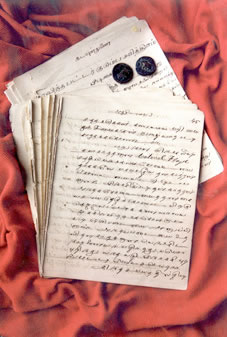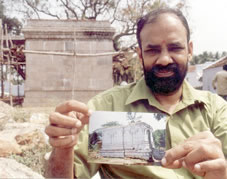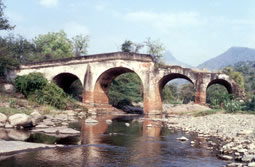|
History Untold
By N. Bhanutej
The Week, February 27, 2005, Page 14 to 28.
 Exclusive Exclusive
An unsung hero who won a critical victory in Tipu’s campaign
By N. Bhanutej
No history book will mention Venkatanarayana Iyer. A soldier who was ranked
the equivalent of a Major in Tipu Sultan’s army, this Brahmin warrior’s
gallantry in stopping the progress of the British army in the late 18th century
is unknown to the world. The yellowed pages of a family manuscript, written by
a certain R. Subbarayar on February 22, 1914, is the only record of Iyer’s
heroics. The manuscript, found recently by a history enthusiast in Coimbatore,
scripts one of the most crucial phases of Indian history, the Third Anglo-Mysore
War of 1790, when British troops clashed with Tipu Sultan’s army in the war
of Satyamangalam.
A tale of its own
The yellowed pages of the family manuscript titled 'Govinda Bhattar's
family history', written in 1914 by R. Subbarayar. History enthusiast S.R.
Krishnaswamy, a Coimbatore-based LIC clerk, procured it from one Shekhar
of Satyamangalam. Also seen are two coins, with the elephant seal, from
Tipu's time.
Iyer played a crucial role in Tipu’s victory over the British in the first
part of the Third Mysore War. The victory, however, was short-lived. Written in
Manipravaalam (old Tamil) and punctuated with a few English words, the text is
titled ‘Govinda Bhattar’s family history’. The war hero, Iyer, is Govinda
Bhattar’s fourth descendant. In the preface, Subbarayar says: "I am the
seventh-generation descendant of Govinda Bhattar, through Govinda Bhattar’s
first son. I am also known in the family as Samanna. I am now 70 years old. I
was interested in history right from childhood. No one in the family recorded
our history. I heard of our background, several times, from many elders in the
family."
Subbarayar mentions that he is attaching the vamsa vruksha (family tree) of
Govinda Bhattar. However, the document is not to be found. "This piece of
history was revealed to me in 1863," he writes. "Apart from this,
other elders who narrated the history should be mentioned here: grandma
Sivagami, my father’s mother, who was born in 1775 and died in 1865, and
Amanni Atthai Paatiyaar (my grand aunt)." Govinda Bhattar, from whose
generation this story begins, belonged to a family of pundits in
Thiruvannamalai. His forefathers held positions in the administration of the
Vijayanagar empire. With increasing attacks on Thiruvannamalai by the Bahamanis
of Bijapur, Govinda Bhattar moved from Thiruvannamalai to Satyamangalam. In
Satyamangalam, as well, this Brahmin family found itself in the echelons of
power, first serving the Nayakas (beginning with Veerappa Nayakar) of Madurai
and later, the Mysore Wodeyars.
 The only remains The only remains
Krishnaswamy holds a picture of the Negamam temple, taken two years ago,
before it was pulled down by villagers. The temple is being rebuilt now
(in background).
Govinda Bhattar’s descendants found favour with Hyder Ali (who had
declared himself independent ruler of Mysore) as well. Describing Iyer,
Subbarayar writes: "He had the build of a warrior. He had likeable
qualities, knew many languages including Daccani. Hyder Ali liked him, and on
knowing his family background, made Venkatanarayana Iyer the head of a
contingent." As part of Hyder’s army, Iyer participated in several
campaigns led by Tipu Sultan, and was made deputy commander of the
Satyamangalam fort (Sathy fort).
Then comes the crucial phase in history. The year is 1790. Governor-General
Lord Cornwallis is determined to "curb his [Tipu’s] insolence and exact
signal reparation for the many injuries that we and our allies have
sustained". (Historical Sketches of the South Indian History by Mark Wilks
and Murray Hammick; Cosmo Publications, New Delhi, 1980). Having entered into
treaties with the Marathas and the Nizam, binding them to unite against Tipu on
the basis of equal division of the spoils, Cornwallis declared war against the
Tiger of Mysore.
The Madras District Gazetteers (Coimbatore) by the late Dr B.S. Baliga, who
was curator of the Madras Record Office (Govt of Madras, 1966), records the
events thus: "Thus began the Third Mysore War. The first stage of this was
mostly confined to operations in Coimbatore and Salem under General Medows, the
new Governor and Commander-in-Chief of Madras. The plan of the English campaign
was that the main division under Medows, after taking all the forts of
Coimbatore and Palghat, was to ascend to the tableland by the Gazzalhatti Pass,
while another division under Colonel Kelly was to invade Baramahal (Salem).
Medows took Karur, Dharapuram, Coimbatore, Dindigul and Erode, besides several
minor places. But when a division under Colonel Floyd established itself at
Satyamangalam, Tipu, leaving his heavy baggage at the top of the Ghat descended
the Gazzalhatti Pass... and attacked it and forced it to retreat."
Interestingly, the Gazzalhatty Pass was the only gateway from the Mysore
frontier to Satyamangalam and Coimbatore. The British army would have been
unstoppable had they secured the pass. Sathy Fort, down below in the plains,
was the last resistance to the British before the Gazzalhatty Pass. Whoever
held Sathy Fort, held the pass. When bastion after bastion held by Tipu’s men
fell to the British, Iyer alerted his chief. Subbarayar’s manuscript notes
that Iyer passed on the intelligence to the "Mohammedan chief" of
Sathy fort.
Though the Mohammedan chief’s name is not mentioned in the manuscript,
Mark Wilks’s book notes that a certain Seyed Saheb, the Sultan’s kinsman,
was in command. "The Mohammedan chief did not believe Venkatanarayana Iyer,"
goes the manuscript. "The polygars wanted Tipu’s rule to end, and opened
their forts and granaries to the British. That’s why the Mohammedan chief did
not get the right picture. He simply smoked his hookah."
Iyer would not rest after passing on the news. He sent word to
Srirangapatnam (Tipu’s capital), and taking five guns (cannons) from the
Sathy Fort, marched his troops to Gazzalhatty Pass. On the foothills leading to
Gazzalhatty Pass, he placed the guns at vantage points and waited for the
enemy. The next day, Colonel Floyd captured Sathy Fort. The laidback commander
ran for his life. Floyd then sent the troops to Gazzalhatty Pass. That was not
to be. Iyer "sent the British troops back in the direction in which they
came", notes the manuscript.
When news of the British attack reached Srirangapatnam, Tipu came to the
summit of the pass with 30,000 men. Lt Col W.J. Wilson, in History of the
Madras Army—Vol. II, says Tipu "suddenly descended into Coimbatore by
the Guzzlehutty Pass with about 40,000 men and a large train of
artillery". Mark Wilks describes this terrain and this grand historical
event thus: "The Sultaun [then]... commenced the descent of this most
difficult pass of the whole eastern range".
Wilks notes that Floyd had early intelligence of the Sultaun’s movements
("it was indisputably confirmed by the desertion of a native officer,
formerly in the English service, who gave an account of the number of
guns"). Floyd’s side of the army comprised six troops of His Majesty’s
19th dragoons, sixteen troops of native cavalry, His Majesty’s 36th foot, and
four battalions of sepoys, including the garrison at Satyamangalam and eleven
guns. In all, the British troops were 3,000 in number. On September 12, Tipu
crossed the Bhavani and camped south of the river near Poongar. The war began a
day later. Despite several losses, Tipu’s cavalry executed lightning
manoeuvres to beat Floyd’s army, which ran to take refuge in the
Satyamangalam fort.
 Bridge from the past Bridge from the past
This dilapidated bridge, which could have been used by Hyder Ali, Tipu
and the British during their campaigns, remains unknown to historians and
archaeologists. The only mention is found in Baliga's Madras District
Gazetteers: "Gazzalhatty... was formerly the principal pass from
Coimbatore to Mysore, one track leading from Satyamangalam and another
from Coimbatore town via Danayakkankottai to the foot of the ghat where an
old-fashioned bridge is still standing." The bridge, in the
Satyamangalam jungle, is frequented only by wild animals. There is no
record about who built this bridge across the Moyar.
The family manuscript reads: "Unable to stand up to Tipu’s force, the
English dalagarthan (chief of the troops) turned and ran into Sathy Fort".
Tipu pursued the British troops. The manuscript adds a crucial detail:
"Two miles west of Sathy, the troops (Tipu’s) mounted canons on the
pillars of the (dilapidated) Negamam temple and rained fire on the Sathy Fort.
The English colonel left the provisions, military equipment and cannons behind
in the Fort and in the dark of the night, crossed the Bhavani in coracles
(basket-boats) and ran towards the south".
The manuscript adds that the dilapidated pillars, unable to bear the weight
and recoil of the cannons, crumbled. Unfortunately, the Negamam temple (also
known as Kenchanoor temple) is no longer there. With nothing to indicate its
historic importance, the dilapidated temple was pulled down two years ago, and
a new temple is being built in its place by the villagers.
Wilks says eight English guns were disabled and that there were serious
casualties among the troops, the horses and the draught oxen. The retreating
English troops marched towards Ukkaram-kavilipalyam (which the British refer to
as Oocara), near the village of Cheyur (Shawoor or Cheyoor). Here, the Sultan’s
army won a decisive victory and proceeded to reclaim all the forts.
The family manuscript notes that Tipu, pleased by Iyer’s gallantry,
decorated and sent him to Chevakad in Kerala. However, a year later, in the
second part of the Third Mysore War, Tipu is cornered by the British and forced
to sign a humiliating treaty which compels him to part with half the kingdom
and three million rupees. To raise money, Tipu orders that the treasures of
Guruvayur temple be handed over. When this order is not carried out, Iyer is
blamed by the governor of Chevakad. However, when Tipu realises that it is the
governor who is in the wrong, he orders his execution. Iyer is stripped of his
honours and asked to leave. Iyer settles in Palakkad after being relieved of
his post.
|

